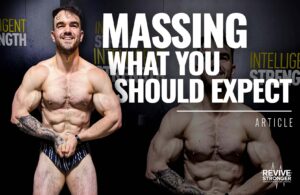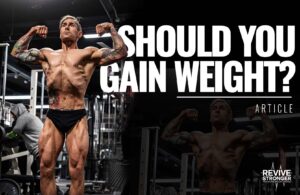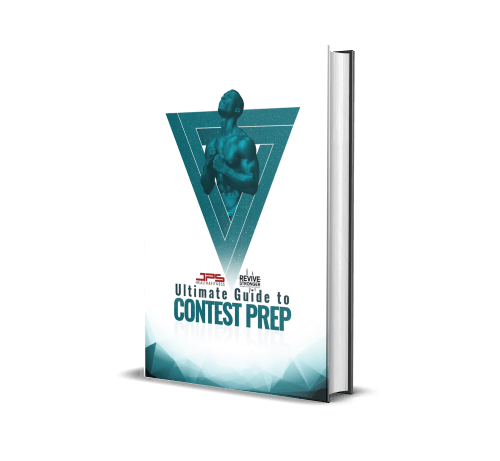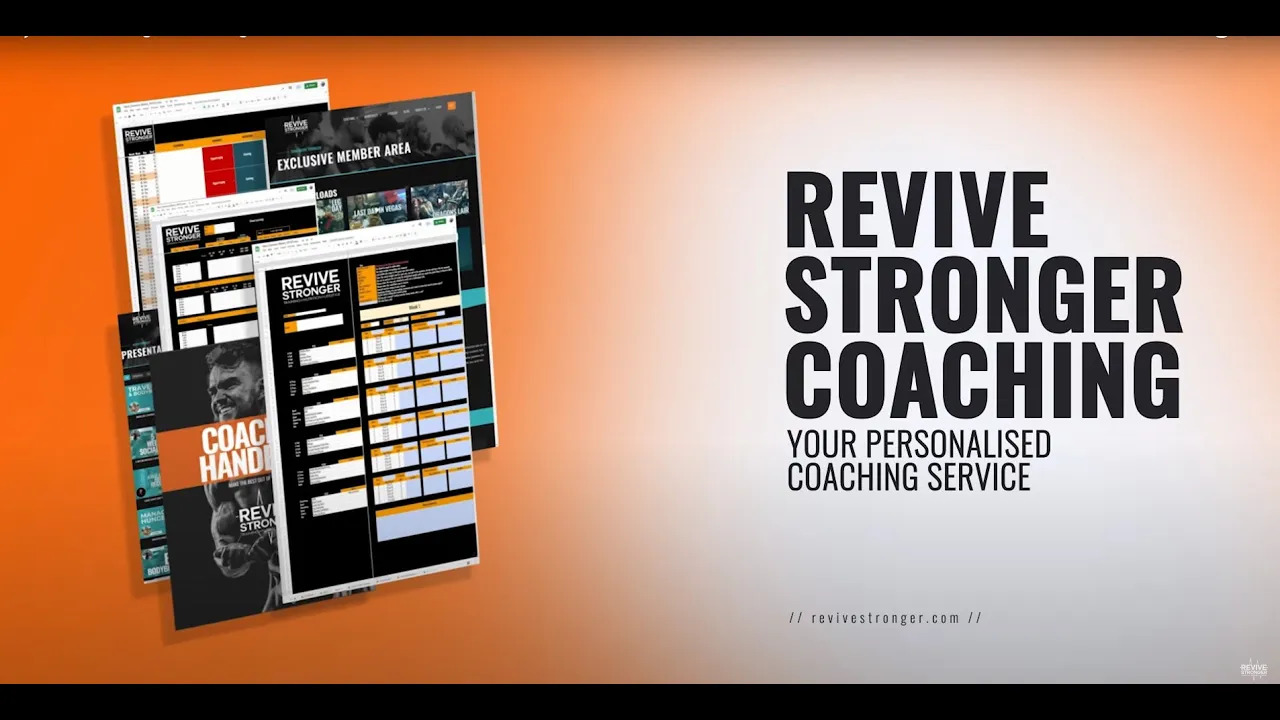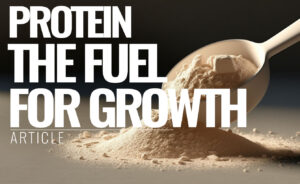
Revive Stronger
11 Gifts Every Serious Powerlifter should have on their Christmas List – (& why)
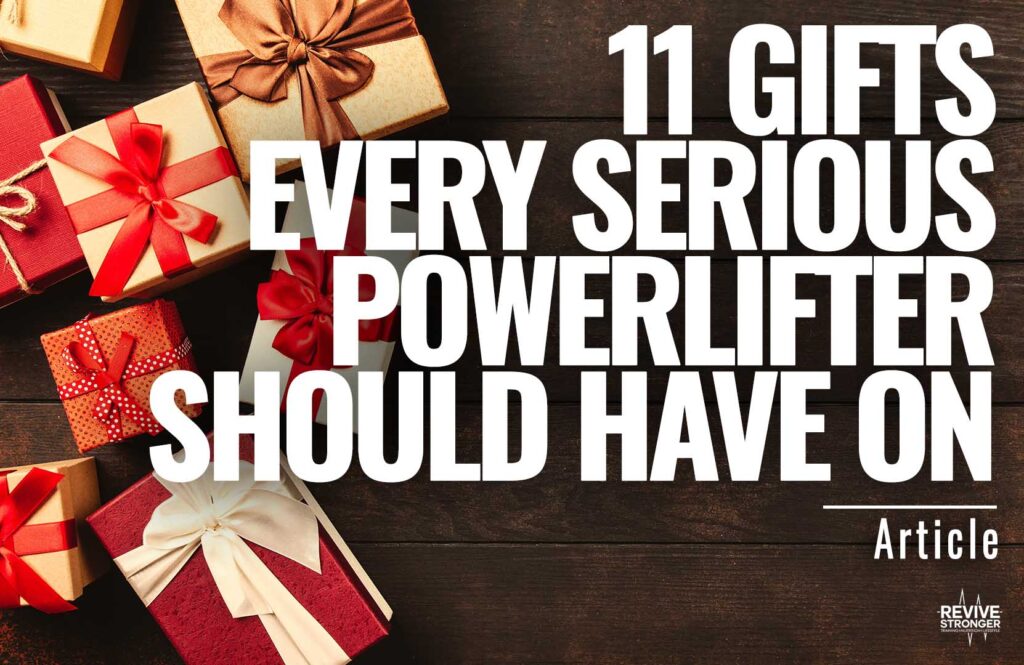
Are you a powerlifter?
Or even just someone who loves to Squat, Bench and Deadlift?
Not sure what you want for Christmas, but know you would enjoy getting stronger?
Well, I have some must have items for any serious Powerlifter, and well what better time to get them than at Christmas. You can tell your friends and family they are helping you get more jacked, and that in turn makes you very happy. So really they are buying you happiness.
As a competitive Powerlifter and Bodybuilder the following list of items are in my opinion are absolute must haves. From aiding my technique and performance to allowing me to carefully modify my training to continually get stronger and more muscular.
Here are my 11 must have gifts for any serious Powerlifter (or Bodybuilder, or lifter of heavy things).
In no particular order.
Table of Contents
1. A High Quality Belt
As powerlifters our sole purpose is to lift as much weight as possible in the squat, bench and deadlift. Do you ever see the strongest powerlifters deadlift or squat in meets without a belt on? No, you don’t because they make a massive difference. Not only do they aid our 1 Rep Max but they help us pull more weight, more effectively and safely throughout our training, they are a must for any serious powerlifter.
Why wear a belt?
The prime purpose of a belt is to indirectly help support the spine, let me explain how. To quote Mark Rippetoe (world renowned strength coach); imagine your car is stuck in the mud, you need to push it to get it out, when you push, what do you do? Do you puff out all the air in your lungs? Or do you hold your breath and brace your core? The second right, and the same goes when we are lifting heavy objects. This is called the Valsalva manoeuvre; holding your breath against a closed glottis (thing tongue to rooth of the mouth) while bracing your core. By filling your stomach you increase the pressure around your core, this pressure acts to reinforce it’s structure, so it doesn’t compress, which further supports the spine, and this allows us to develop more force.
So you want to be doing this regardless of whether you are wearing a belt or not, but a quality belt will aid this intra-abdominal pressure, as it provides further anterior support. The belt provides a wall for you to push against. Think of it like a barrel, they have metal rings surrounding the middle, this is to provide further support at the weakest point. So you want to take a big, held breath and brace your core into the belt, not only will this allow you to produce more force and lift more, it’ll also be safer.
[bctt tweet=”You want to take a big, held breath and brace your core into the belt.”]
The Biggest thing to avoid when buying a belt
There are certainly better belts to go for, and the most important thing for me is that it needs to be 4 inches all the way round. Some belts are tapered around the front, but for me this completely misses the point of the belt, as we learned above you are to contract your abs into it, and this produces more support. If the belt is thinner around the front the abs have less to act against and thus you will not get the support desired. So make sure it is the same width all the way round, and best is 4 inches as this is the max allowed in most powerlifting organisations.
I am going to sound like a hypocrite now, but I do believe there is a special case for a tapered belt and that is if the width causes a problem. Now that does sound pretty dumb I realise, but some people on the smaller side may find the belt digs into their ribs and hips, and some larger guys might find it stops them getting into position for the deadlift. A tapered belt would alleviate this problem, and for them would be a better option.
Still the only occasion you should not have it 4 inches all the way round is if it causes a problem, because the more coverage on the abs by the belt, the higher the intra-abdominal pressure, which will lead to more poundage being lifted.
My Recommendation
I personally advocate spending a little extra and getting a higher quality belt, or rather getting a loved one to do it for you. Tell them to just think of all the PRs they’re giving you, the gift that just keeps giving. The reason being is I’ve had experience with cheaper belts, and well, these haven’t been good experiences. Since I purchased a higher quality belt I’ve never regretted the decision, in my opinion if you are looking to lift some serious weight it is more than worth the money. Having said that so long as the belt isn’t tapered it’ll be better than not wearing one (so long as you use it right, more on that in a bit).
You want a leather belt, this will provide far more support than a velcro belt, end of story. There is then a choice between either a lever or prong, a lever allows the belt to be easily open and close, and a prong works just like a standard belt buckle. I’ve had both and while the lever was convenient, I have found the prong belt of more use. This is because to change the lever tightness you have to use a screw driver, which is a pain in the ass if I am honest.
You may find you require a different level of tightness for certain lifts, for example it is not uncommon to want a looser fit when deadlifting or warming up. Plus levers are much more likely to break, and even with a long warranty you still have to go through some hassle that a prong won’t give you. Plus if you are like me and going through periods of gaining and losing weight you will no doubt have to change the lever position. So a prong in my opinion just makes life easier (which is funny as this is what a lever is meant to do).
You can get double or single prong, I went single because I thought back to any belts I owned with two prongs and they were again, a pain in the backside. So I’d opt for a single prong.
[bctt tweet=”When trying to pull heavy weight you want to make everything else as easy as possible. “]
Now how thick do I recommend you go? I’d say both 10mm and 13mm would be fine for most people, if you are a bit on the slighter side, then 10mm is probably a good choice. I personally use a 10mm belt and get great support from it, however that isn’t to say 13mm wouldn’t provide a tad more support. I personally have an Inzer belt, and never had an issue, plus they provide a lifetime guarantee on their belts. I got mine from the dutch site because for people in the UK or Europe the shipping is far less and takes much less time. – Inzer Belt
How to use it?
It’s all well and good having a belt, but once you’ve got it you need to know how to use it. Far too many guys just whack them on for every movement and expect it to somehow magically protect their back and let them lift huge weights. From the above you know this is not the case, the belt is an aid to allow you to create more intra-abdominal pressure, nothing more, nothing less.
So once you’ve got it, use it right and the best way to get it right is practice. Mark Rippetoe gives a pretty good way to identify the right position, you simply put the belt on around your mid-section, not tight, and then squat down, come back up, and the position it settles is the right place for you. You can then tighten it until it provides a little pressure to the gut, but you can still breath. Like everything it will depend on the person, find what suits you.
To give an example think of the deadlift, once you have your chosen tightness and positioning perform the Valsalva manoeuvre as described previously (holding a deep breath and contracting your abs) get tight and pull! In the video above you can clearly see (and hear) me performing this before I lift.
So as a Powerlifter you would be a bit silly to not wear a belt, they increase spine stability and force when used correctly. If you’re completely new to powerlifting then you better have perfect technique and be on the verge of lifting reasonably heavy weights, if you don’t tick these boxes first then wait till next year.
2. Wireless Headphones
OK so wireless headphones aren’t essential, in that you don’t need them to compete in powerlifting, in fact you cannot wear them during your competition lifts, but I think they’re very handy. Wires are just an absolute pain, I’ve tried to come up with novel solutions to make sure they don’t get in the way, but they always do somehow. And to be honest some of the methods I tried were downright dangerous, wires that could get caught up with heavy weights is never a good thing. That is why wireless headphones are so essential in my opinion, you don’t have to worry about keeping your music device on you or wires dangling around.
Why Music?
It’s an ergogenic aid, in that it has the ability to increase our performance physically and mentally by reducing fatigue. The most common positive outcomes when combining music and exercise appear to be decreased ratings of perceived exertion (RPEs), increased performance measures, improved mood, and increased arousal. The reason has not been clearly identified but it is thought that we focus on the music rather than the act, and this in turn allows us to perceive less fatigue.
[bctt tweet=”Who doesn’t lift better when their favourite tune comes on?”]
In one study 20 resistance trained men were selected to investigate the effects of Self Selected Music (SSM) on strength, explosiveness, and mood during an acute bout of resistance exercise. It was found that SSM increased squat jump explosiveness and feelings of vigor, tension, and fatigue. Bench press reps to failure and associated RPE was not significantly impacted by music, so SSM had no effect on reps to failure in a multiple-set strength exercise [1]. Based on these results, it appears that motivating and or SSM may be beneficial during acute explosive, high-intensity exercise. Sounds like powerlifting no?
Using that combined with my experience with music we can safely say it can somewhat aid our power when lifting, and for powerlifers this is essential. However, I will note that the participants experienced increased post exercise fatigue under the SSM condition, and this is likely down to performing the exercise at a greater intensity. So you need to be careful when using music, it might not be a good idea to get ramped up all the time, because it’ll take you out of line with your ‘real’ fatigue levels. The same could be said for any ergogenic aid, I would recommend not abusing them, and potentially even periodising their use with your training or only using them when necessary.
I personally always listen to music, but don’t always allow myself to get massively amped up. I try and save my caffeine and heavy bass music for the weeks before my deload, when I am aiming to overreach and create a lot of fatigue.
My Recommendation
I have personally only ever owned two different types of wireless headphones, neither massively expensive. The key with both was that they didn’t get in the way of any of my lifts and were secure in my ears. Now we’re not looking to run or jump in these, so they don’t need to be crazy secure.
My first pair were over-ear and were very cheap at under £20. They worked well and the sound quality was fine, but I did find I got a bit hot in them; say hi to sweaty Steve. The battery life was really good too, they’d last a good 10 hours, but the connectivity was a bit iffy and didn’t travel far, maybe 10 meters. Also after about a year they did break (for no apparent reason) and I replaced them with the same pair but they wouldn’t connect to my iPhone, and that was that really. – Arctic Sound Bluetooth Headset 
Sound quality is again good, they get pretty loud and can drown out the awful gym music. Their connectivity is also superior, covering a good 25 meters. The only downside to these so far is they have a tiny battery life, of around 2 to 3 hours, so I personally charge them after every workout. After about 6 months of use they are still holding strong, but are a bit more expensive at around £50. – Jabra Sport Wireless
3. Knee Sleeves
The next must have for any serious powerlifter are knee sleeves. These are essentially neoprene gloves for your knees they maintain warmth, improve blood flow and provide an external shell of pressure, keeping the knee cap and surrounding structure in place. They are beneficial as they keep our knees healthier. However, they are an aid, not a support like wraps, if you’re using them as a support, stop and seek a professional examination of your knee before you do long term damage.
Why use knee sleeves?
When you’re frequently squatting heavy the chances of developing knee tendinitis increases, it is essentially an over-use injury and training in a cold environment makes you particularly susceptible. Our knees get cold quite easily because there isn’t a lot of blood flow around them, to keep them warm. Personally I noticed in my accumulation phases or periods of high volume my right knee starts to twinge a little, this is knee tendinitis creeping in. Knee sleeves help prevent or reduce flair ups of knee tendinitis. So they’re are a real must have for a serious powerlifter, as they can help keep you training harder for longer and that is vital to any powerlifters success.
[bctt tweet=”Knee sleeves are like a warm bed on a cold morning…you don’t want to get out”]
Now which sleeves should you go for? Well this questions pops up time and time again with my clients who are venturing into powerlifting and I give the following answer; if you’re looking for something you can wear for virtually all lifts then go with a Rehband, however if you are simply looking for something to squat in and want to get the most aid/performance boost the sleeve to go for is the SBD.
SBDs are longer (by 3cm) so provide more coverage, thus more support and carryover. They also have a lot of size options available, which means you can get them to fit better, and if they’re tighter they again will provide more support and potential carryover. As you can imagine they are however more expensive, but you know what they say; you get what you pay for. I’ve personally got the SBDs and find they keep my knees healthier and definitely give me a boost out of the bottom of my squat. – SBD Knee Sleeves / Rehband Knee Sleeves
4. A Solid Squat Shoe
Next up is a solid squat shoe, to quote Mark Rippetoe; “it just takes one set of 5 to convince someone they need a pair”. Mark argues they provide enough efficiency to the movement to make the cost justified.
Why specific squat shoes?
The main reason I find a squat shoe aids a lifter, is the stability. Every time I see someone squatting in a running shoe a little part of me dies inside. You see to squat in such a soft, cushioned sole is like squatting on a mattress, you lose force, stability and overall power and this not only prevents good form but it kills our potential strength.
A key quality of a squat shoe is a solid base, this provides us a solid surface to drive up through, you can screw your feet to the ground and not lose any force through compression. If we lose force we lose power, and this is a big no, no.
In addition I like to see a strap across the shoe, because this acts like a weightlifting belt on a lifters torso, it adds further stability, and with that allows for greater force production.
[bctt tweet=”Every time I see someone squatting in a running shoe a little part of me dies inside.”]
Your squatting style and flexibility will dictate the shoe you require. Olympic lifting shoes with an added heel height will decrease the mobility required for the movement making it easier to reach depth and maintain good posture. If you lack ankle mobility, primarily dorsi-flexion (toes pointing up) a raised heel can help a lot.
However if you utilise a wide stance squat any movement of the knees forward increases the range of motion (ROM) because the knees will drop lower as they track forward, and when this happens the hips have to go even lower to make depth. A large reason people opt to squat wide is to limit the ROM, allowing them to shift more weight. So a heeled shoe would increase ROM, and that isn’t something you as wide stance squatter would therefore want to use. Unless of course you’re a quad dominant squatter and have big powerful quads, then a heeled squat shoe would probably be of benefit.
My Recommendation
I have personally squat in the following; Converse, Vibram 5 Finger KSOs, Strength Shop Lion Oly Shoes, Nike Romaleos 2.0 and Reebok Crossfit Lite TRs. All of these are OK shoes, but some in my experience are better than others. I am personally a quad dominant squatter and don’t use an excessively wide stance, therefore the raised heel helps me get depth and make best use of my powerful quads.
Honestly, if you’re going to get an Olympic squat shoe you cannot go wrong with the Romaleos, they have a solid sole (some Oly shoes are rubber and still compress under load), plus they have not one but two straps providing full support for your feet. If you’re a wide stance squatter then I’d shoot for the Reebok Crossfit Lites, these were develop by Mike Bell (world renowned powerlifter) and provide a solid flat base to lift from. – Nike Romaleos / Reebok Crossfit Lite TRs
5. A Minimal Shoe for Deadlifts
Now if you’re buying shoes you may as well pick up a decent pair for deadlifts while you’re at it. Again much like squats the right deadlift shoe can improve your lifting effectiveness and therefore strength.
Why specific deadlift shoes?
Please do not try and deadlift in anything but a minimal hard soled shoe, let me explain why. When we deadlift we are pulling the bar from the ground upwards until our hips lockout at the top. If you add any sort of heel or thicker sole you are creating a larger ROM, putting you at a leverage disadvantage. Think about it this way; are you stronger pulling from a deficit or from the floor? It’s always going to be the floor. If your wear anything but a minimalist shoe you are adding needless ROM to your lift and making it unnecessarily harder.
Oh and just like you don’t want to squat off a mattress, deadlifting off one isn’t any good either, so to make sure you’re not losing force through your shoe, deadlift in one that’s sole doesn’t compress.
My Recommendation
I’ve personally deadlifted in; Converse, Reebok Crossfit Lite TRs, Vibram 5 Finger KSOs and Merrel Trail Gloves. All of these would be fine choices, they have hard flat soles, however the Vibrams and Merrels are ‘bear foot’ shoes, meaning they have a very thin sole. For that reason these are my preferred shoes to deadlift in, and of the two I would opt for the Merrels simply because they’re easier to put on and off. I can go from squatting in my Oly shoes to deadlifting in my Merrels with ease, the same isn’t so true for the Vibrams as you either need special toe socks or need to take extra socks with you. Also you cannot wear deadlift socks with the Vibrams, and you will see why that is an issue later. – Merrel Trail Glove
6. Lifting Chalk
There is nothing worse than your grip giving out during your heavy pulls, powerlifters cannot allow their grip strength to hold them back. Straps can help but are not allowed during competition, so if you can avoid using them it’ll only help you on meet day.
Why chalk?
One of the big reasons we lose grip is due to the bar slipping out of our hands, this might be down to poor knurling and it could be down to sweaty palms, either way it’s no good. Chalk is great because it combats both of these, it aids our grip by creating more friction between our hands and the bar and it dries our hands out, keeping the skin tight.
My Recommendation
Personally I recommend you pick up liquid chalk, because standard chalk is hard to transport and many gyms don’t allow it because it can create a mess. Liquid chalk on the other hand comes in an easy to use and transport bottle, and doesn’t go everywhere. What a great stocking filler. – Liquid Chalk
7. A Progressive Training Programme
Arguably more important than anything else I have recommend thus far is to make sure you’re on a progressive training programme. If as a powerlifter you’re following a generic plan you found in Men’s Health or through Google you’re probably not being very efficient with your time. If you want to succeed as a powerlifter you need to be doing a periodised programme that is individualised for you. Your training age, weak points, strong points, size, gender and ability will all influence how you want to train.
Why is programming so important?
The key to getting stronger, more muscular and powerful is a progressive programme. That means you need to be doing more overtime to continually challenge your body to elicit an adaption; in other words you need to shift more weight or reps or your body will not improve. It simply has no reason to.
[bctt tweet=”Map out a programme for big lifts”]
So the key is to train in a progressive manner, and that means finding a programme that suits you and your needs. And as a powerlifter you have very specific needs. Past the first 6 months of training we need to go into the gym with a plan, you can’t just expect to see improvements every workout. You need to have a long term plan, this is called periodisation.
My Recommendation
Now you can try and find suitable programmes online, but to be ultimately successful you need to get one bespoke to you. You can do that in a variety of ways, you could get a coach, you could join one of my groups (muscle building group, fat loss group) or you could learn how to programme for yourself (something like my ebook Get Big Stay Lean, or the below).

I personally own tonnes of books that all go over programming for strength, including Practical Programming by Mark Rippetoe and Kilgore and Supertraining by Mel Siff and Yuri Verkhoshansky, but hands down my number one recommendation to you would be The Scientific Principles of Strength Training by Mike Israetel, James Hoffman and Chad Wesley Smith. It might be because I have read so many damn text books about training that finally everything has sunk in, or it could be because the book is written incredibly well and is easy to understand. Either way this book gave me an ‘aha’ moment when it came to programming.
In the book they take you through all the important strength training and programming terms, and even introduced some nuanced principles like Maximal Recoverable Volume (MRV) and Stress Recover Adaption (SRA) curves. They go over the foundational principles to programme design and break them down one by one, allowing you to understand why each is important and how to use them to help you design your training. The idea behind the book is to empower you with the knowledge to create effective training programmes. – The Scientific Principles of Strength Training
8. Foam Roller
If you look into your programming you will learn that fatigue management is very important. The more recovered you are the better you will be able to train, and thus the stronger you can ultimately get as a powerlifter. Also if you cannot get into the required positions for squatting, deadlifting or benching without pain then you’re not going to get very far. Foam rolling can really help you out.
Why should you foam roll?
I like to think of foam rolling as a very cheap massage. Current evidence suggests that in the short term foam rolling can increase flexibility and doesn’t harm performance. It has been found to increase flexibility in the long term too. Some people find it reduces perceived soreness and reduces pressure pain (DOMS- delayed onset muscle soreness). [2]
No one really knows how foam rolling affects flexibility and DOMS; it’s thought that it is probably down to neurophysiological mechanism. I know personally if I get on a foam roller for a bit I do feel looser and more relaxed, it works, so I do it. I’ve also done it with clients and we have seen immediate increases in range of motion, improved mechanics and pain relief.
[bctt tweet=”Foam rolling plus stretching is a potent combination”]
So foam rolling before exercise can be a great way for powerlifters to improve their flexibility without impacting performance, which could allow them to meet depth in a squat, get their shoulders comfortable when pressing or get into position to deadlift most effectively. Stretching has also shown to increase short term flexibility, but through different mechanisms, thus the two would be a pretty potent combination. Also done post workout it could allow for powerlifters to reduce their muscle soreness and promote faster recovery rates.
My Recommendation
Now because there isn’t a tonne of evidence showing miraculous benefits of foam rolling I don’t think you need to spend a fortune on a foam roller. However, I’ve worked in gyms in the past where the rollers just break and ruin with use. So I think if you can spend a little bit more money (or your friend or family member can) then you should get a more durable foam roller, which is likely made from rubber. I personally own a rumble roller, this has lasted me over 2 years (in fact I got it for Christmas) and it is still in mint condition. The smaller ridges on it are also pretty neat at finding trigger points (and by neat I mean painful). – Rumble Roller
9. Wrist Wraps
The next must have for any serious powerlifter are wrist wraps, yet another handy accessory to generate more power and strength.
Why wrist wraps?
Have you ever gone to bench press and had your wrists bend backwards? This hyper-extension of the wrist blunts your force transfer, and that in turn reduces the amount you can lift. Wrist wraps aid your bench by keeping your wrists straight, you get maximum power transfer between the bones of the wrist and the forearm.
[bctt tweet=”Avoid benching with limp wrists”]
Also as I said they provide support and this can come in handy when squatting too. Mark Rippetoe may hate on me but I don’t squat with flat wrist and a thumbless grip. I personally like and recommend a thumb under grip with bent wrists when squatting. I find this allows people to take a closer grip which helps provide a tighter upper back which is essential when squatting (Mark would agree). However, with the wrists bent you end up taking a lot of pressure, so wrapping them can help support the wrists and alleviate some of the strain. As said before, lifting with pain is no good and it will kill your lifts.
My Recommendation
You may notice a trend going on here, in that I think you get what you pay for and that if you are really serious about lifting maximal loads you want to get the best equipment. Plus I think this higher quality stuff will last longer, and in the end be better value for money. So when it comes to wrist wraps I recommend getting stiff longer wraps, these will provide more support than shorter flexible wraps. I actually own a pair of 60cm SBD flexible wraps, these however are incredibly stiff, and I have found they provide a great deal of support. – SBD Wrist Wraps
10. A Quality Lifting Shirt
You’re a powerlifter, not a bodybuilder, so you have no place wearing vests or stringers. Actually screw that, if you’re not squatting then go for it, but a T Shirt is preferable when you’re getting under the bar.
Why a T Shirt?
Unlike skin a good t-shirt won’t allow the bar to slip. In fact many powerlifters chalk their back up when squatting to help further make sure the bar stays put. So you should also be avoiding anything that is nylon or synthetic, for risk of bar slippage. Clothing worn should also not impact movement in anyway, and never make the movements that are already hard, harder.
Furthermore, in meets a t-shirt must be worn under the lifting suit by all lifters in the Squat and Bench Press and by women in the Deadlift; men do not need to wear a t-shirt in the Deadlift (although it must be plain or have a logo they accept).
My Recommendation
I like t-shirts that are fitted and a mixture of cotton and polyester, because they can stretch easily and do not restrict movement. That just happens to be exactly what my Revive T Shirts are made from, in fact I made it a key criteria when sourcing them. They fit very well, and look pretty good too, plus you’re supporting me! – Revive T Shirt
11. Deadlifting Socks
My final must have gift for the serious powerlifter is deadlifting socks. Yup socks to deadlift in, these are actually a requirement when you compete in a powerlifting meet, and they are just good to have when training too.
Why deadlifting socks?
When we deadlift the Bar wants to be mid foot (conventional) or touching our shins (sumo), with shoulders in-front of the bar and lifted vertically from there. The closer the distance between the point where the scapula is vertical to the bar and the point where force is applied to the ground the easier it is to pull, and the closest it can get to this place is touching your shins with a flat back at the correct angle.
Without socks you’ll end up with gashes on your shins, potentially, and I’ve been there when I don’t intentionally scrape my shins but end up opening the old cut, blood everywhere. Keep your bar clean and your shins cut free by eliminating this problem with socks.
My Recommendation
Honestly so long as they cover your shins there are no special requirements here, old football socks would do the job fine and that is exactly what I wore for my first powerlifting meet. However, I do really like Reebok crossfit knee high socks, they’re thin and aren’t excessively long, plus they have some pretty sick designs too. – Reebok Knee High Socks
11 Must Have Gifts for any Serious Powerlifter
- High Quality Lifting Belt – Inzer Belt
- Wireless Headphones – Jabra Sport Wireless
- Knee Sleeves – SBD Knee Sleeves / Rehband Knee Sleeves
- Solid Squat Shoe – Nike Romaleos / Reebok Crossfit Lite TRs
- Minimal Sole Deadlift Shoe – Merrel Trail Glove
- Lifting Chalk – Liquid Chalk
- Progressive Training Programme – The Scientific Principles of Strength Training
- Foam Roller – Rumble Roller
- Wrist Wraps – SBD Wrist Wraps
- Quality T Shirt – Revive T Shirt
- Knee High Socks – Reebok Knee High Socks
So there you have it 11 must have gifts this year for any serious powerlifter or person who wants to shift the most weight possible. Now you have even more reason to be good, get your nutrition right and hit your training sessions, because we all know what bad boys and girls get for Christmas…
References:
- MATTHEW S. BIAGINI, LEE E. BROWN, JARED W. COBURN, DANIEL A. JUDELSON, TRACI A. STATLER, MARTIM BOTTARO, TAI T. TRAN, AND NICK A. LONGO. EFFECTS OF SELF-SELECTED MUSIC ON STRENGTH, EXPLOSIVENESS, AND MOOD. 26(7)/1934–1938 Journal of Strength and Conditioning Research (2012)
- http://www.strengthandconditioningresearch.com/foam-rolling-self-myofascial-release/
- M. Rippetoe & L. Kilgore – Starting Strength – Basic Barbell Training (2007)
- http://www.powerlifting-ipf.com/
We are a personal coaching service that helps you achieve your goals. We want you to become the best version of yourself.














